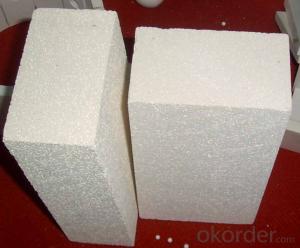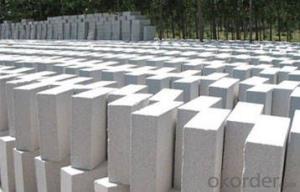Insulating Fire Brick - Refractory Mullite Insulating Refractory Brick JM 89
- Loading Port:
- Shanghai
- Payment Terms:
- TT OR LC
- Min Order Qty:
- 5000 kg
- Supply Capability:
- 10000 kg/month
OKorder Service Pledge
OKorder Financial Service
You Might Also Like
Refractory mullite insulating refractory brick JM 23
Okorder series heat insulation brick
Okorder series thermal insulation brick is an effective, energy saving, low carbon, environmental protection advanced, according to the ASTM standard manufacturing products. Okorder series products are best Li Ning and insulation in all types of industrial furnaces in the metallurgical field, aluminum, petrochemical, electric power and glass ceramic materials. They can be used as part of the working layer of thermal insulation or non - melting. Products have been widely used in the following furnace, achieved satisfactory results.
Application of heat preservation brick
Metallurgical Industry: blast furnace, hot blast furnace, heating furnace, etc..
Petrochemical Industry: ethylene cracking furnace, hydrogen production furnace, primary reformer, heating furnace, etc..
Ceramic industry: roller kiln, kiln, etc..
Glass industry: glass furnace regenerator, etc.
Carbon industry: carbon furnace, etc..
Aluminum electrolysis industry: aluminum reduction cell, etc.
Other industries: tunnel kiln, shuttle kiln, etc..
Advantages of heat insulation brick
Low thermal conductivity: more porosity will bring good thermal insulation effect, energy saving.
High crushing strength: high crushing strength, volume stability.
Low heat storage: small heat storage to absorb more heat, energy-saving effect is obvious.
Gao Chundu: iron, alkali metal impurity content is low.
The precise size: Brick size processing precision, special shape cutting and grinding, accelerate the brickwork.
Insulating brick picture
Common problem solutions
1. What products do you have?
We have all kinds of refractory bricks, refractory casting materials, mortar, cement, ceramic fiber products, etc..
Or you can browse our products to choose what you need.
2. How to control product quality?
With strict quality control system throughout the material selection and production process, we have the quality of refractory materials and ceramic fiber products to meet customer requirements.
From the selection of raw materials, the quality of our control to start. The quality certificate of the raw material is required, each batch of the products are to be tested in the use of the forward line. In the production process, the quality control by the workers, and then each piece of classification, and through the quality supervision and inspection.
3. Can you give me a brief introduction to the application of your product?
My company is mainly engaged in refractories in the steel, cement, glass, ceramics, petrochemical, electric power and other industries.
4. What information do you need if I need you?
In order to select the right products, we will provide us with information, such as the United States, technical data, order quantity, product application, etc..
If you have any questions, please contact us.


- Q: Can insulating fire bricks be used in the construction of refractory-lined vessels?
- Insulating fire bricks have the capability to be utilized in the construction of vessels lined with refractories. These bricks are specially designed to possess low thermal conductivity, making them an ideal choice for applications that require insulation. When constructing refractory-lined vessels, insulating fire bricks are commonly placed in the outer layers of the lining to offer insulation and minimize heat loss. This contributes to enhanced energy efficiency and the maintenance of high temperatures within the vessel. Nevertheless, it is essential to consider that insulating fire bricks may not be suitable for all sections of the refractory lining, particularly in areas where high mechanical strength or resistance to chemical attack is necessary. In such instances, alternative types of refractory bricks may be necessary.
- Q: Are insulating fire bricks resistant to hydrofluoric acid?
- Insulating fire bricks are not resistant to hydrofluoric acid. Hydrofluoric acid is a highly corrosive substance that can attack and dissolve many materials, including fire bricks. It is important to handle hydrofluoric acid with extreme caution and use appropriate protective equipment when working with this hazardous substance.
- Q: Can insulating fire bricks be used in outdoor fire pits?
- Certainly, outdoor fire pits can make use of insulating fire bricks. These bricks are specifically engineered to endure high temperatures, rendering them suitable for fire pit applications. They are crafted from heat-resistant materials like ceramic fibers or refractory substances, which aid in preserving the heat within the fire pit. Moreover, insulating fire bricks possess a lightweight composition and are effortless to install, making them a practical selection for outdoor fire pits. Nevertheless, it is crucial to bear in mind that these bricks may not possess the same level of durability as regular fire bricks. Thus, they might necessitate more frequent replacement if exposed to extreme temperatures or harsh weather conditions.
- Q: Is the quality of brick made of small-sized self insulation block equipment the same as that of large block brick equipment?
- Recently, a lot of people have encountered this problem, Silver Horse understand, in fact, the brick machine is only the production of different production, the quality of the bricks produced are the same.
- Q: Can insulating fire bricks be used in the construction of melting furnaces?
- Insulating fire bricks can indeed be utilized in the construction of melting furnaces. These bricks are specifically designed to withstand high temperatures while possessing excellent thermal conductivity. Their primary purpose is to minimize heat loss and conserve energy, rendering them highly suitable for melting furnaces. Additionally, these bricks are lightweight and easily manageable, providing convenience during construction. They are also capable of effectively retaining heat and maintaining a steady furnace temperature, thus ensuring efficient melting and casting processes. Moreover, insulating fire bricks exhibit resistance to chemical corrosion and mechanical stress, showcasing their durability and reliability for long-term use in melting furnaces. In conclusion, considering their thermal properties, ease of use, and durability, insulating fire bricks are a fitting choice for constructing melting furnaces.
- Q: Can insulating fire bricks be used in heat treatment furnaces?
- Indeed, heat treatment furnaces can make use of insulating fire bricks. These bricks are specifically engineered to possess a low thermal conductivity, enabling them to endure elevated temperatures while minimizing the dissipation of heat. This quality renders them ideal for deployment in heat treatment furnaces, where the preservation of a stable temperature is vital for the triumphant execution of the heat treatment procedure. Moreover, insulating fire bricks exhibit exceptional insulating attributes, thereby curtailing energy usage and enhancing the overall efficiency of the heat treatment furnace. Consequently, the utilization of insulating fire bricks in heat treatment furnaces is a prevalent practice across diverse industries.
- Q: Are insulating fire bricks resistant to reducing atmospheres?
- Yes, insulating fire bricks are resistant to reducing atmospheres.
- Q: What are the different sizes and shapes available for insulating fire bricks?
- Insulating fire bricks come in various sizes and shapes to cater to different applications and requirements. The sizes of insulating fire bricks typically range from standard sizes like 9" x 4.5" x 2.5" (commonly referred to as "9-inch bricks") to smaller sizes like 9" x 4.5" x 1". These standard sizes are widely used in the construction of fireplaces, kilns, furnaces, and other high-temperature applications. In addition to standard sizes, insulating fire bricks are also available in custom sizes, allowing for greater flexibility in design and construction. These custom sizes can vary depending on the manufacturer, but they generally follow the same width and length measurements as the standard bricks. Regarding the shape, insulating fire bricks are commonly rectangular or square-shaped. The rectangular shape is the most common and versatile, allowing for easy installation and arrangement in various structures. Square-shaped bricks are also available but may be less commonly used. It's worth noting that insulating fire bricks can be further categorized based on their density or insulation value. These bricks are typically classified into three categories: low-density, medium-density, and high-density. Each category has different insulating properties, with low-density bricks offering the highest insulation value. Overall, the wide range of sizes and shapes available for insulating fire bricks allows for customization and adaptability to different construction projects, ensuring optimal insulation and heat retention in high-temperature applications.
- Q: Can insulating fire bricks be cut to size?
- Yes, insulating fire bricks can be cut to size using various cutting tools such as saws or knives.
- Q: Can insulating fire bricks be used in glass furnaces?
- Yes, insulating fire bricks can be used in glass furnaces. Insulating fire bricks are designed to have low thermal conductivity, which makes them ideal for use in high-temperature environments like glass furnaces. These bricks help to reduce heat loss from the furnace, resulting in improved energy efficiency and reduced operating costs. They also provide better insulation and help to maintain consistent temperatures inside the furnace, which is crucial for glass production. Additionally, insulating fire bricks have good resistance to thermal shock and can withstand the extreme temperatures and rapid temperature changes that occur in glass furnaces. Overall, the use of insulating fire bricks in glass furnaces can contribute to better furnace performance, increased productivity, and energy savings.
Send your message to us
Insulating Fire Brick - Refractory Mullite Insulating Refractory Brick JM 89
- Loading Port:
- Shanghai
- Payment Terms:
- TT OR LC
- Min Order Qty:
- 5000 kg
- Supply Capability:
- 10000 kg/month
OKorder Service Pledge
OKorder Financial Service
Similar products
Hot products
Hot Searches
Related keywords






























